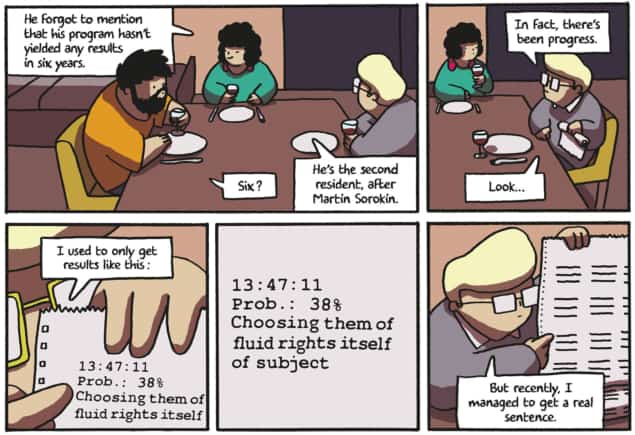James Kakalios reviews The Phantom Scientist by Robin Cousin (translated by Edward Gauvin)

During the first year or two of the COVID-19 pandemic, many of us spent time doing jigsaws. Some of the puzzles will have been easy, some more challenging. But they all had two things in common. First, we knew what the final picture should look like (it was right there on the box cover). And second, the only way to finish the puzzle was to try a given piece and check where it might fit.
There is no formula for solving a jigsaw puzzle. We can start by separating out edge pieces or those of a similar colour. But ultimately, trial and error is the only viable way to complete it. In the jargon of computer science, any program for solving a jigsaw puzzle is what’s known as “NP” – we can check if a particular trial is the right solution, but we have no direct way to get there without guesswork.
But there are many situations where there is a formula for solving a problem. If, say, you want to find the largest value in a list of random numbers, you can write a simple computer program to look at each pair of numbers and keep the larger of the two values until you’ve checked them all. These are what are known as “P” problems.
They are quicker to solve than NP problems that have the same number of items (be it numbers on a list or pieces of a jigsaw puzzle). But no-one has yet proved that NP problems can never be solved using P algorithms. What’s known as P ≠ NP is one of the biggest unsolved problems in computer science and plays a central role in The Phantom Scientist – a new graphic novel by French computer scientist Robin Cousin.
Translated into English by Edward Gauvin, Cousin’s novel is an engaging mix of mystery, science fiction and complexity theory, told through artwork that is simple, uncluttered and easy to follow. It takes place at the fictitious Institute for the Study of Complex and Dynamic Systems, inspired by Cousin’s experience of a real-life lab belonging to the French National Centre for Scientific Research (CNRS) in Paris.
Every seven years the institute’s hit by some kind of dramatic and fatal catastrophe, which requires all researchers to leave and a new director to be appointed
The institute in the book is not short of space, resources or funding, having only 24 scientists (and some support staff) spread out over seven buildings in a wooded campus. As the director of the institute explains to Stephane Dousay, the 24th scientist to join: “You are free to conduct your research as you see fit. We ask only that you file regular reports.” (I did say it was a science-fiction story.)
What’s also unusual about the institute is that every seven years it’s hit by some kind of dramatic and fatal catastrophe, which requires all researchers to leave and a new director to be appointed. It is, if you like, a living experiment in nonlinear dynamics, described by one protagonist as being “engineered to create…an instability conductive to major scientific discoveries”. Or, as one outgoing director says in a video message to his successor: “Like all dynamic systems, the institute tends toward entropy and chaotic behaviour.”
The story actually begins six years into the fourth incarnation of the centre with the arrival of Stephane, a physicist who studies pattern formations in budding plants. The other scientists in Stephane’s building are Louise (a linguist), Vilhem (who is working on a computer program that will predict upcoming events in his life), and an occupant whom no-one has ever seen and about whom little is known.
The languid, almost cinematic pace of the story pulls the reader in, creating a sense of space and time
Eventually, we learn that this mysterious researcher, the phantom scientist of the title, is reputed to have made a major advance in the study of complexity of computer algorithms. Weird things start to happen at the institute. Louise discovers notes left in the eponymous researcher’s lab that suggest he’s (spoiler, it is a he) developed an algorithm that enables previously intractable problems to be quickly solved. And then the bodies start to pile up.
I’ll say no more about the story to avoid giving the game away. However, I will note that the forest location for the campus is important as it lets Cousin show his characters doing mundane things like walking – silently and alone – from one facility to another. Or they’re shown fixing dinner in their apartments or programming their computers in the lab.

A graphic tale of entanglement
The languid, almost cinematic pace of the story pulls the reader in, creating a sense of space and time that contrasts with the change in tempo as events accelerate towards the end. It also provides Cousin with an opportunity to plant clues and hidden references in the story, many of which I missed on first reading.
In fact, this is a novel that rewards rereading. It touches on everything from origami and kirigami to the Fibonacci sequence and the “sofa problem” (what’s the largest area of a sofa that can be manoeuvred through a one-metre wide L-shaped hallway?). There’s also a deeper point, which is that even if computer algorithms replace trial and error, we will still always need human ingenuity. As Stephane says regarding the sofa problem: “No-one’s ever solved it, but I’ll bet a mover could eyeball it in an instant.”
- 2023 MIT Press 128pp $24.95hb



